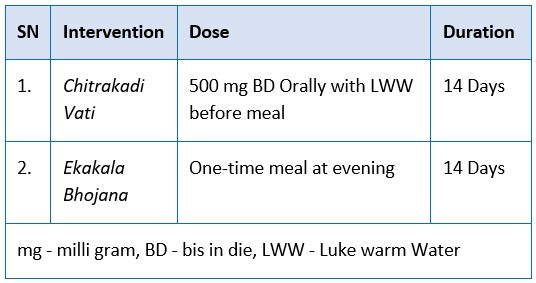Management of Mandagni (~diminution of Agni) a case study; evaluating the effect of Chitrakadi Vati and Ekakala Bhojana (one time meal in day) in alleviating gastrointestinal symptoms
DOI:
https://doi.org/10.21760/jaims.9.3.38Keywords:
Mandagni, Chitrakadi Vati, Case report, Ekakala Bhojan, AyurvedaAbstract
Ayurveda, an ancient medical science, emphasizes the balance of Tridosha (Vata, Pitta, Kapha), proper functioning of Dhatus (tissues), and enhancement of Agni (digestive fire) for maintaining health. Mandagni, or diminished Agni, is a common ailment in Ayurveda associated with various gastrointestinal symptoms. This case study aims to evaluate the efficacy of traditional Ayurvedic interventions, specifically Chitrakadi Vati and Ekakala Bhojana (one-time meal in a day), in alleviating Mandagni and its related gastrointestinal manifestations. The study documents the case of a 38-year-old female patient exhibiting symptoms of Mandagni, including abdominal and head heaviness, cough, weakness, and tastelessness. Treatment involved Chitrakadi Vati and Ekakala Bhojana, aimed at enhancing Jatharagni and alleviating symptoms. Assessment criteria encompassed subjective and objective measures, showing improvements in symptoms and laboratory parameters post-treatment. Discussion highlights the pharmacological actions of Chitrakadi Vati and dietary modifications of Ekakala Bhojana in promoting digestion and alleviating symptoms. The study concludes positively, suggesting the efficacy of these Ayurvedic interventions in managing Mandagni and enhancing overall well-being.
Downloads
References
Sharma H, Chandola HM, Singh G, Basisht G. Utilization of Ayurveda in health care: an approach for prevention, health promotion, and treatment of disease. Part 2—Ayurveda in primary health care. The journal of alternative and complementary medicine. 2007 Dec 1;13(10):1135-50.
Agnivesha, Charak samhita, Chikitsa sthan, Grahnidosh chikitsa 15/51., Vidyotini commentary by Pt. Kashinath shastri and Dr. Gorakhnath Chaturvedi, Part 2, Chaukhambha Bharti Academy, Varanasi 2009.
Sushruta, Sushruta Samhita with Nibandha Sangraha teeka of Dalhana,Uttaratantra Adhyaya 64/56,edited by Vaidya Yadavaji Trikamaji, Reprint Ed. Choukhamba Surbharati Prakashana,2008; 812.
Dhoke SP, Bhadarva A, Vyas VH, Vyas MK. Importance of Healthy Dietary Pattern wsr to Dwadasha Pravicharna. Pharma Science Monitor. 2016 Jul 1;7(3).
Susruta, Susruta samhita, Sutr Sthan, Chapterss.35 Ver.29, edited by Ayurveda tatva sandeepika, hindi commentary by virajaambikadatta shastri, Chaukhambha Sanskrit sansthan, Varanasi Edition: reprint, 2017.
https://niimh.nic.in/ebooks/ecaraka, Chikitsa Sthan, Ch. 15, Ver.96-97. (Last accessed on 18th June 2021, 12:29 am.
Kumar PB, Kadibagil VR, Ganti BY. Role of Chitrakadi Vati in Grahani roga. Int Ayu Med J. 2016;4(2):121-9.
Mesnage R, Grundler F, Schwiertz A, Le Maho Y, Wilhelmi de Toledo F. Changes in human gut microbiota composition are linked to the energy metabolic switch during 10 d of Buchinger fasting. Journal of Nutritional Science. 2019;8:e36. Doi:10.1017/jns.2019.33















